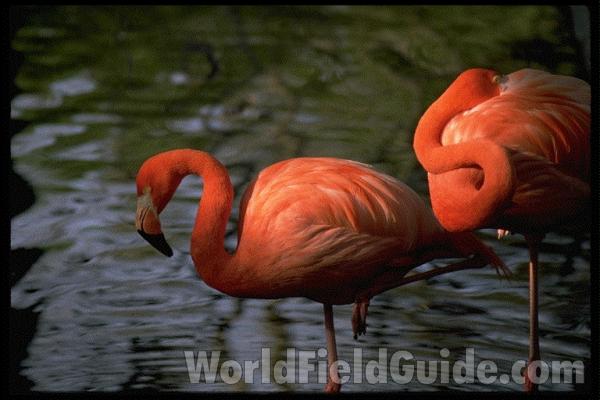SPECIES INFO
Greater Flamingo (Phoenicopterus ruber) is found in the Caribbean, South America, southern Europe, and Africa. Breeding populations are found in several semitropical settings in the United States in Florida. In Europe the areas where this is found are now limited. Perhaps Spain, southern France, and Turkey still contain populations. This flamingo also breeds in Madagascar and Aldabra. Greater Flamingos are pale pink and are about fifty-six inches in length.
There are two subspecies. The nominate subspecies Phoen. ruber ruber is found along the coasts in the Caribbean. This is found along some island coasts, along some Central American coasts, and along some South American coasts. The subspecies roseus is found in southern Europe and central Asia including northwestern India. This is also found in northern, eastern, and southern Africa.
One would suspect that the southern European form would have been described first, but Linnaeus described the New World form in 1758. Pallas described the Old World form in 1811.Flamingos (Genus Phoenicopterus) are found primarily in the Caribbean, South America, and Africa. These unusual long legged birds fly from lake to pond and stand in shallow water and move their bills back and forth to seine for their food. There were 5 recognized species in Monroe and Sibley (1993):
P. ruber - Tropical Old World and the tropical Americas
P. chilensis - Andes Mountains and southern South America
P. minor - Africa
P. andensis - Andes Mountains and southwestern South America
P. jamesi - Andes Mountains and southwestern South America
Flamingos (Family Phoenicopteridae) are found in Central America, South America, Southern Europe, and Africa. These birds are characterized by very long legs and their unusual method of eating. They sweep their heads back and forth through the water using their bills as a seine to filter out small animals.
Stork and Heron group (Order Ciconiiformes) is made up of birds with long legs that usually are found near the shores of bodies of water. Their long legs let them wade through the shallow water looking for food. Fossil remains indicate these birds have been around for at least 100 million years. There are about 114 living species in this group.
Aves contains about 8,650 different species of living birds known to science. Each year about one new species is discovered in some remote rain forest or remote island. In addition, scientists have been raising many subspecies to full species status which may raise the species count to 10,000. Birdlife recognizes 10,027 species as of 2011.
However, each year about one species goes extinct. The rate of extinction is increasing, and the rate of new discovery is decreasing, so that the number of bird species will soon begin to decline rapidly. Although different taxonomists would organize the birds differently, there are approximately twenty-seven orders of birds. These orders are broken down into about one hundred and fifty-five different families.
Recent research of the genetic structure of some of the shore birds and owls would indicate that the present organization of orders and families should have some modification.
The birds are a worldwide group of animals that are characterized by having the front limbs modified into wings that are used for flying. Perhaps the most unique feature of the birds is the feathers. These feathers are made up of a central support called a quill and a series of small filaments that are hooked together as barbs.
For many years it was believed that Archaeopteryx discovered in Bavaria was the oldest bird from about 150 million years ago. However, in l986, Sankar Chattterjee, a Texas paleontologist, reportedly discovered a bird in the genus Protoavis that lived about 225 million years ago.
When this project was begun in 1978, we used Austin & Singer for bird taxonomy. Since then, we have adopted many changes, but have kept some older concepts that are still found widely in the literature. Recently, we have used Clements and Howard & Moore. Very recently, we have used Monroe and Sibley for the higher taxonomy of the perching birds.
Backboned Animals (Phylum Chordata) are the most advanced group of animals on earth. These animals are characterized by having a spinal cord or backbone. Most members have a clearly defined brain that controls the organism through a spinal cord. Fish, amphibians, reptiles, birds, and mammals are in this phylum.
Currently, some taxonomists believe that the fish should be divided into two groups (sharks and regular fishes) and that there are some other primitive groups in the phylum such as hagfish or lampreys.
Animal Kingdom contains numerous organisms that feed on other animals or plants. Included in the animal kingdom are the lower marine invertebrates such as sponges and corals, the jointed legged animals such as insects and spiders, and the backboned animals such as fish, amphibians, reptiles, birds, and mammals.














